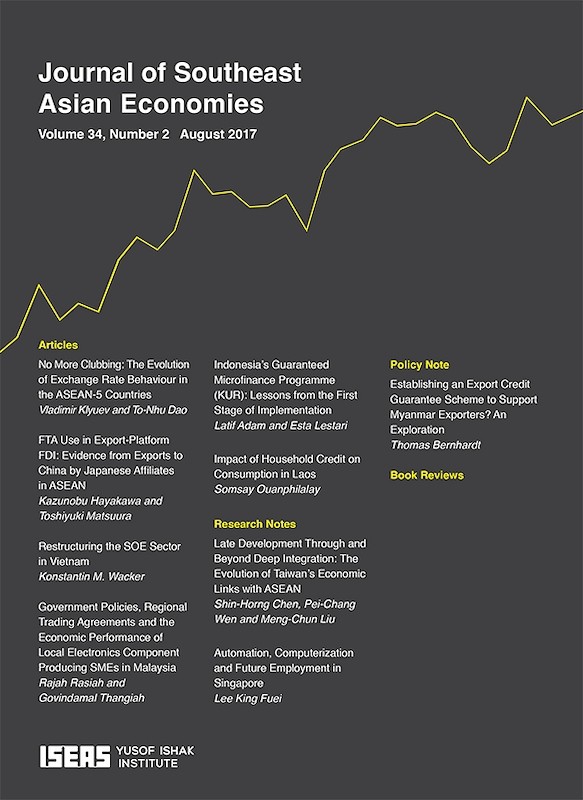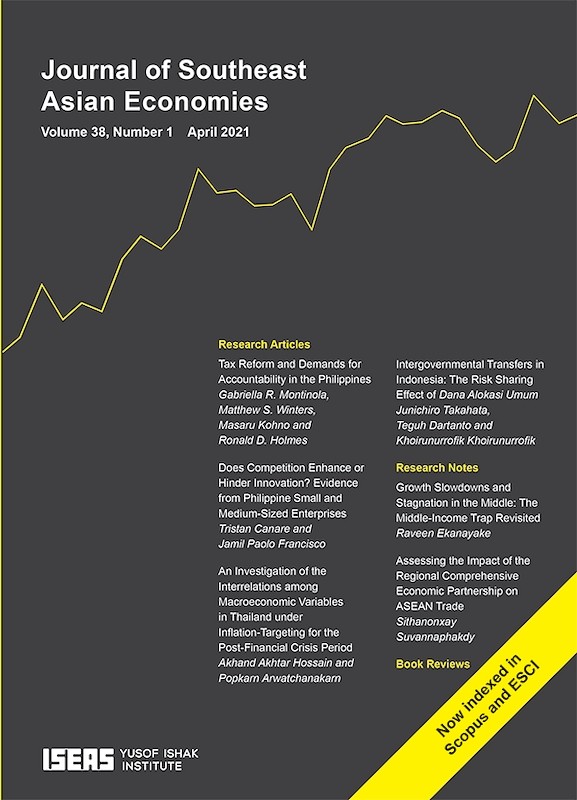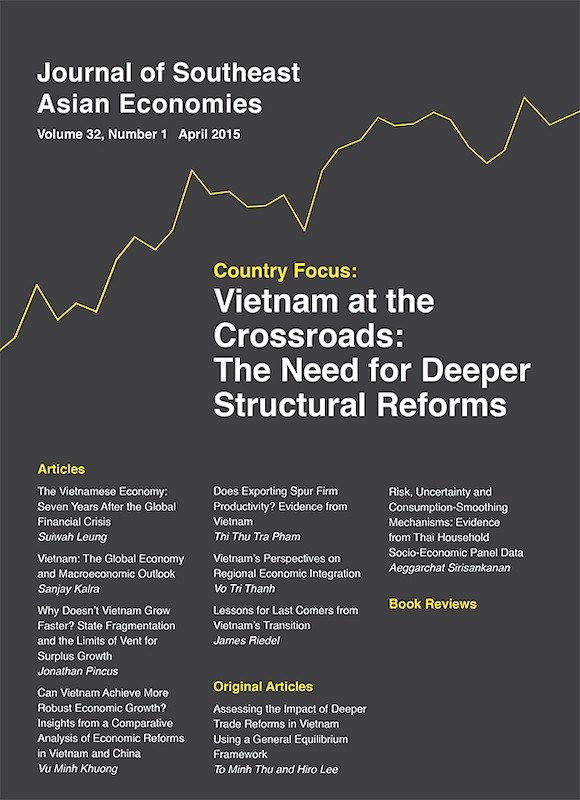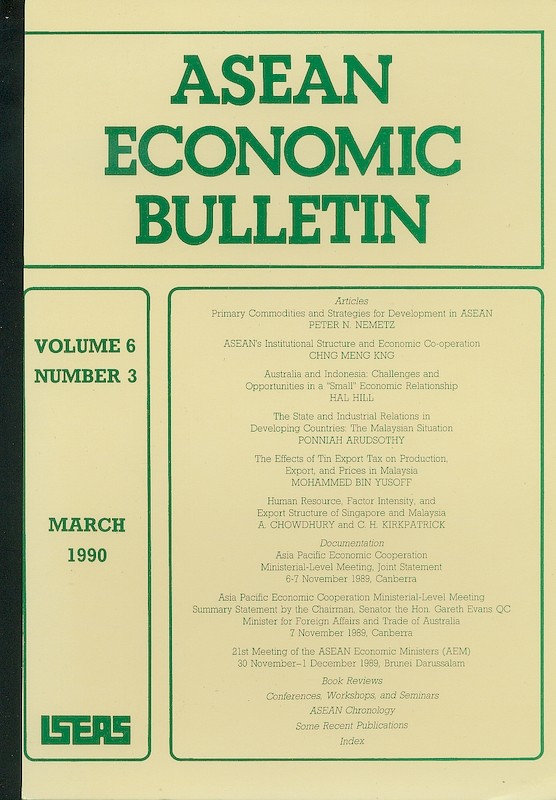ASEAN Economic Bulletin Vol. 22/2 (Aug 2005)

Date of publication:
August 2005
Number of pages:
136
Code:
AE22/2
Contents
-
ASEAN Economic Bulletin Vol. 22/2 (Aug 2005)
-
Preliminary pages
- ARTICLES
-
From Grain-sized Innovations to Triple-Test Patents in ASEAN: Patterns, Issues, and Implications in Development and Competitiveness, by Ngo Van Lam, Thitapha Wattanapruttipaisan, authors see abstractWidely famous for its economic dynamism, ASEAN is not well known as a region of intellectual property creation. Patented assets owned by regional entities have remained very small in volume, notwithstanding the fast-paced, electronics-based transformation in regional production and trade from the 1990s. This is a matter for significant concern because inventions and innovations are the foundation of durable comparative advantage, higher value addition, and high value-added activities. Inevitably, the technological creativity and capabilities of ASEAN have to be shifted upwards for better synergy with the greatly intensified global competition, the accelerating technological progress, the more sophisticated and exacting market requirements, and the stronger and broader protection of intellectual property rights. The transition process will be highly demanding on resources, imagination, and perseverance, not least because capacity- and institutional-building requires lumpy investment, changed mindsets, and long periods of gestation. Nevertheless, the outstanding and speedy transformation in microelectronics capabilities among the East Asian developing economies gives grounds for guarded optimism as regards the prospects for transitional success among the miracle economies in Southeast Asia.
-
Exchange Rate Volatility and Exports for Selected East Asian Countries: Evidence from Error Correction Model, by Wai-Ching Poon, Chee-Keong Choong, Muzafar Shah Habibullah, authors see abstractThis paper examines the relationship between exchange rate volatility and exports of the five selected East Asian economies. A measure of the quantitative proxy of the exchange rate risk is constructed, focusing on the role of moving-average in smoothing the persistence of the risk measure. Vector auto-regressive (VAR) model, error correction modelling (ECM), and variance decomposition (VD) are applied to characterize the joint dynamics of variables in both the short and long run. The Johansen results indicate a stable long-run relation between exports and exchange rate. Results show that a great fluctuation of exchange rate volatility has significantly impacted the volume of exports for the economies concerned. To this end, the forecast error VD shows that the innovations of exchange rate volatility have minor impact on export patterns in the study.
-
Assessing Singapore's Export Competitiveness through Dynamic Shift-Share Analysis, by Peter Wilson, Ting Su Chern, Tu Suh Ping, Edward Robinson, authors see abstractThis paper uses dynamic shift-share analysis to examine Singapore's export performance in electronics and chemicals in the export markets of the United States, the European Union, and Japan over the period 19882001. It compares Singapore's export competitive position against a group of reference economies: China, Hong Kong, Korea, Malaysia, and Taiwan, which are close competitors in these markets. Previous studies on Singapore using shift-share methods have tended to focus on the one- or two-digit export classification. By contrast, the present paper looks at specific three-digit electronics categories and chemicals which are particularly important for analysing Singapore's current and future export strengths and weaknesses. Our findings identify 1996 as a turning point, after which Singapore's net positive gains in electronics exports compared with the reference economies shifted towards losses, but this need not be a problem if Singapore can continue to evolve from exporting final electronics products to the developed markets, to supplying higher end intermediate electronics components to support assembly-type operations in the other East Asian economies. Chemicals have also emerged as a possible new source of growth within the manufacturing sector.
-
How Significant and Effective Has Foreign Aid to Indonesia Been?, by Anis Chowdhury , Iman Sugema, authors see abstractWith the improvement of relationship with the Western countries after the demise of the Old Order regime of President Soekarno, Indonesia received a large volume of foreign aid that played a crucial role in the recovery of the economy. Indonesia remained a significant recipient of foreign aid throughout the 1970s and 1980s. However, no systematic study has been done so far on the effectiveness of foreign aid in Indonesia. This paper, thus, attempts to examine the historical significance and effectiveness of aid flows to Indonesia. The correlation between aid and economic growth was found to be positive, but low. However, aid flows were crucial for maintaining development and social expenditure, especially at times of crises. In addition, aid flows smoothed out balance of payments problems and played an important catalyst for policy reforms; but there were also evidence of reversing reforms. The certainty of aid flows helped the government to follow the balanced budget principle, but made the government lazy in terms of domestic resource mobilization. As a result, despite significant progress, Indonesia's external debt burden remains high, and it has little ability to handle crisis without substantial foreign aid. Because of a weak domestic revenue base, the uncertainty regarding fiscal sustainability remains unresolved.
-
Role of the State in Contract Farming in Thailand: Experience and Lessons, by Sukhpal Singh, author see abstractThe nation-states have been attempting large number of policy measures to institutionalize contract farming as a solution to the problems of agricultural development. This paper examines the role of the Thai state in the promotion of contract farming for agricultural development. After a review of the literature on the role of contract farming, it analyses the role of the Thai state in contract farming and finds that although the state intervened intensively in contract situations, and contracting is widespread across crops and regions, contracting has not led to desirable consequences and remains a predominantly farmer company relationship with the intermediation of middlemen. The paper concludes with lessons for contract farming policy with focus on the nature and quality of the role of the state.
- RESEARCH NOTE
-
Disaster Risk Management in Southeast Asia: A Developmental Approach, by Benjamin Loh, author
- BOOK REVIEWS
-
BOOK REVIEW: Political Economy of East Asia: A Business Model, by Linda Low., by Robert L Curry, Jr., author
-
BOOK REVIEW: Developing Asian Bondmarkets, Edited by Takatoshi Ito and Yung Chul Park., by Sakulrat Montreevat, author
-
BOOK REVIEW: Rural Development and Agricultural Growth in Indonesia, the Philippines and Thailand, edited by Takamasa Akiyama and Donald F. Larson., by Jan P Voon, author
-
BOOK REVIEW: Foreign Investment in Developing Countries, edited by H. S. Kehal., by Amarendu Nandy, author
-
BOOK REVIEW: Innovative East Asia: The Future of Growth, by Shahid Yusuf et al., by Benjamin Loh, author





